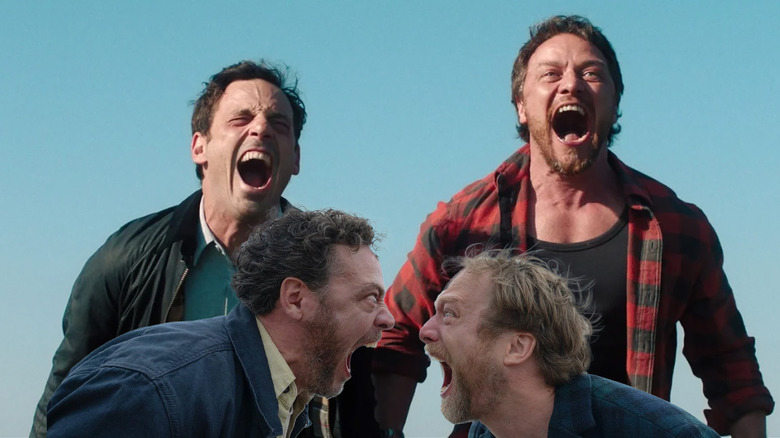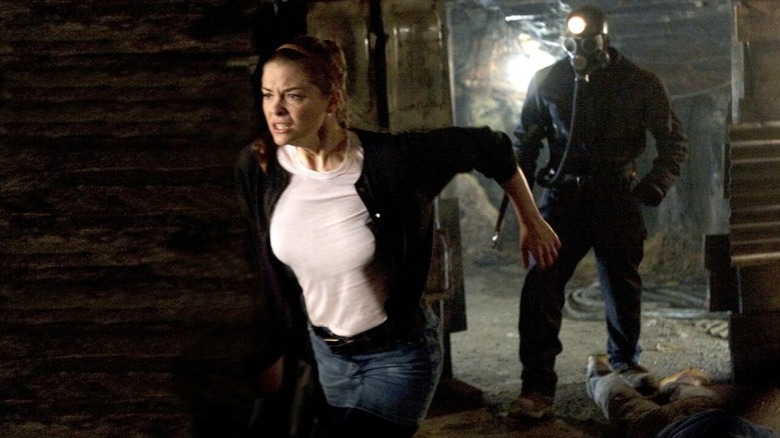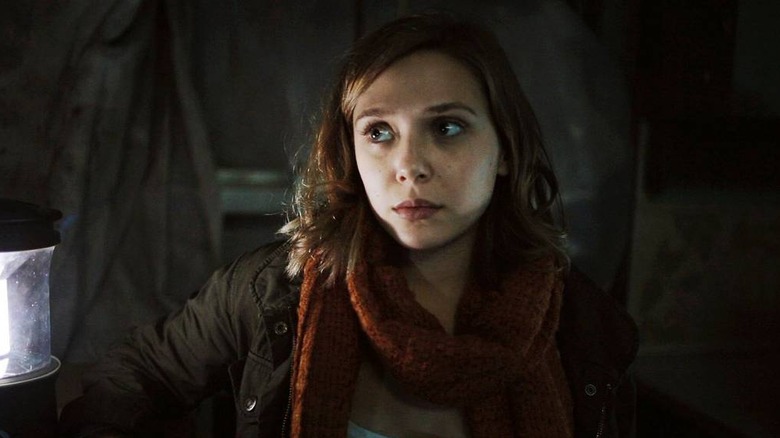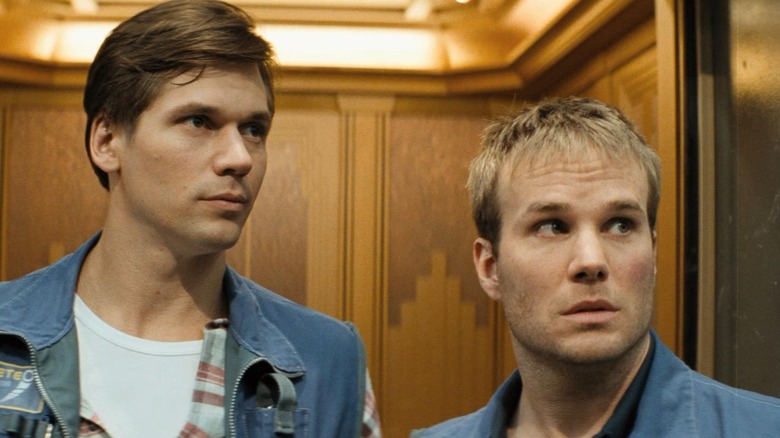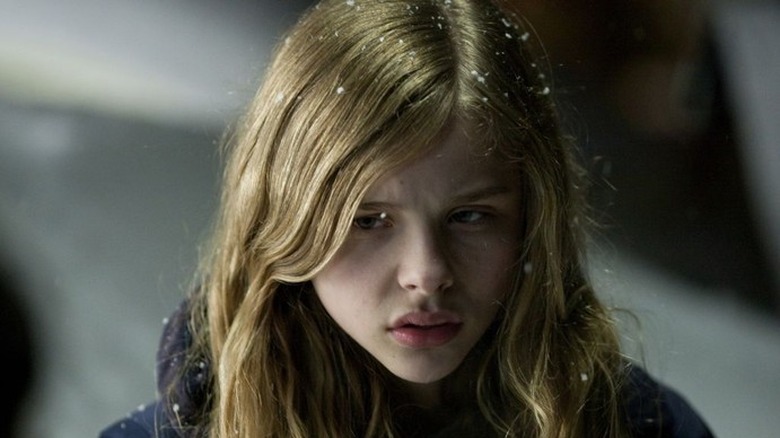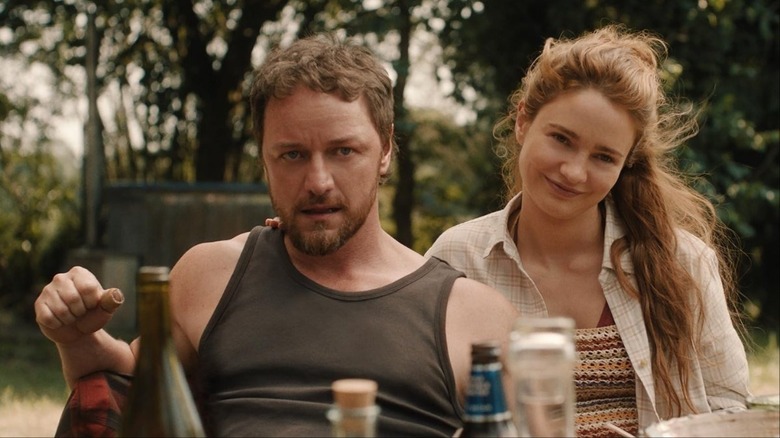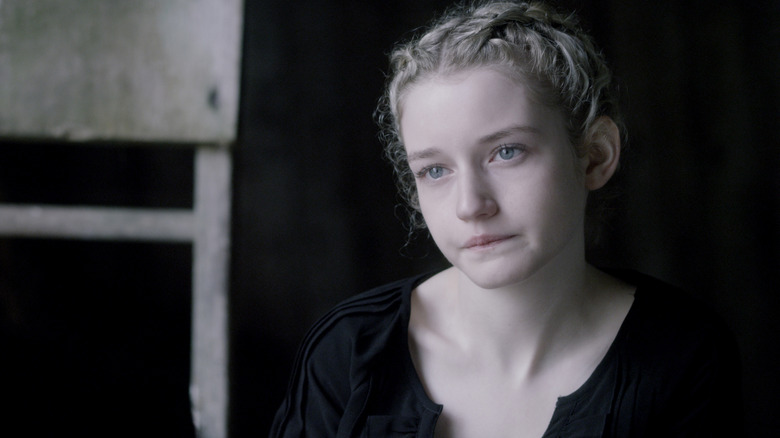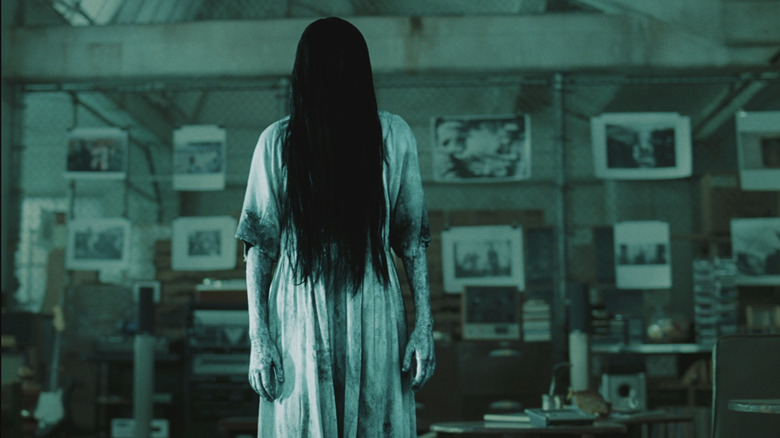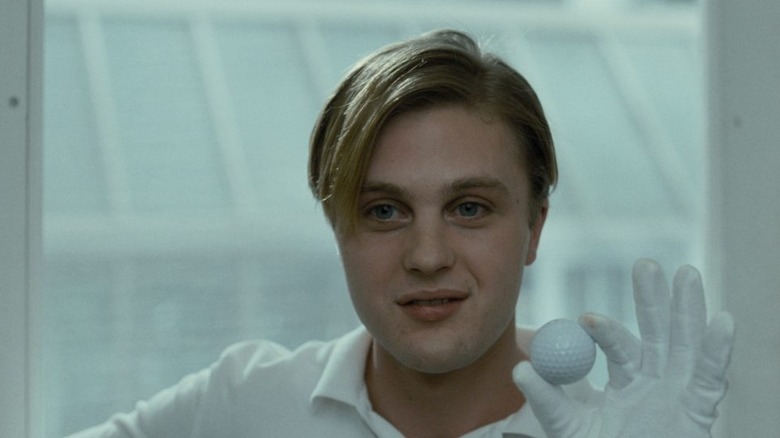The 8 Best American Horror Movie Remakes, Ranked
Horror films have always been a way to interrogate the anxieties of a time, society, or culture and reflect them to the viewer — like a twisted funhouse mirror. Fear is a universal emotion and history is known to repeat itself, so horror is a genre filled with remakes, some of which are very good. Sometimes, like in the case of Leigh Whannell's "The Invisible Man," a remake evolves into something entirely different than the original story to better resonate with modern audiences. And sometimes a remake is, unfortunately, nothing more than a blatant cash grab from a studio looking to squeeze some blood out of the all-holy stone of "Recognizable IP."
And then there are the most controversial of all remakes: the Americanized remake.
Despite the knee-jerk reaction claiming otherwise, American remakes are neither inherently inadequate nor synonymous with "unnecessary." TV shows like "Shameless" and "The Office" are American remakes, and their popularity far surpassed their original counterparts. But when it comes to horror, a delicate balance is required for success. Fear is so specific to our surroundings and lived experiences, that remaking a film from one culture for another isn't always so easy. There's also the unfortunate baggage that comes with a built-in model for comparison, in addition to the depressing reality that way, way too many Americans outright refuse to engage with non-American media — those incapable of overcoming what Bong Joon-ho rightfully called the "one-inch-tall barrier of subtitles." Americanizing can feel like erasure when done with disrespect, but when done properly, it's almost like witnessing an exercise in localization.
That exercise is often wildly successful, so I've wrangled up eight of the very best American horror movie remakes that will hopefully inspire folks to check out the originals that inspired them, and remind studios pursuing remakes how to do it right.
(Author's note: A special shout out to Wes Craven's "Last House on the Left," which is technically a remake of Ingmar Bergman's "The Virgin Spring," and Luca Guadagnino's "Suspiria," which stars some American actors and was eventually distributed by Amazon, but was ultimately an Italian production.)
8. My Bloody Valentine 3D
Many don't realize that "My Bloody Valentine 3D" from 2009 is an American remake because most forget that 1981's "My Bloody Valentine" came from our neighbors to the north in Canada. "My Bloody Valentine 3D" exists at the intersection of both the remake boom of the 2000s and the sudden obsession with 3D applied to films like "Piranha 3DD," "The Final Destination," and "Jackass 3D." For my money, "My Bloody Valentine 3D" was most definitely the horror film that did it best, and as the first R-rated film released using RealD technology, it's also a historic achievement.
The film follows similar beats, with a mining town under attack on Valentine's Day by a pickaxe-wielding killer in a mining mask. All signs point to the killer being the ghost of Harry Warden, a miner who survived a devastating collapse years prior, having killed the other miners to conserve oxygen and went on a killing spree a year later before disappearing for a decade. Like many of the best remakes, both "My Bloody Valentine" and "My Bloody Valentine 3D" are strong in their own unique ways, with the latter more of a murder mystery and less of a hack 'n' slash. But where the Americanization really shines is in its updated setting and attitudes, with a tone reflective of the diminishing coal industry in America rather than the booming source of employment of the 1980s. 15 years later, it's hard not to imagine what a potential third remake might look like now that the coal industry is on life support. Hey, if fellow Canadian slasher "Black Christmas" can justify two remakes, Harry Warden can have another go-round too.
7. Silent House
Before Elizabeth Olsen joined the Marvel Cinematic Universe as Wanda "Scarlet Witch" Maximoff, she got her start the way so many other actors did before her and broke through in genre films. While "The Iron Claw" director Sean Durkin's "Martha Marcy May Marlene" marked her feature debut, it was the American remake of "Silent House" that helped her gain mainstream attention. The 2011 home invasion thriller was an American remake of the 2010 Uruguayan film, "La Casa Muda" which itself was alleged to be based on a true event that happened in Uruguay in the 1940s. Both films utilized a "real-time" found footage approach, using camera tricks to give the impression the films were filmed in a single, continuous shot.
Directed by Chris Kentis and Laura Lau, "Silent House" starts out as a standard home invasion creep-fest, but slowly transforms into a psychological nightmare carried on Olsen's shoulders. The flick lives and dies by her performance, which is arguably stronger than the Uruguayan original. Both films descend into some deeply upsetting territory storywise and removed from the marketing that played up the continuous take gimmick and action sequences, "Silent House" is in a better place now to be appreciated for the story it's trying to tell than either film was over a decade ago.
6. The Shaft/Down
2001's "Down" aka "The Shaft" is the exact kind of delicious B-movie schlock that we should be remaking every five years. An American remake of the 1983 Dutch-language film "De Lift," the original director returned to remake his own debut feature and the result is a hell of a fun and goofy time. The original flick is like the weirder cousin of technology-run-amok flicks like "Chopping Mall" and "Maximum Overdrive," but with a lightning storm sparking the AI "biocomputer" controlling an elevator to start acting with malice.
Released direct-to-video back when that expression was a dirty word, "The Shaft" is a wild experience. Instead of rehashing the original beat-by-beat (more on that later), it went balls-to-the-wall with the truly bananas concept and took no prisoners. Naomi Watts, queen of the Americanized remake, stars as Jennifer Evans, a journalist tasked with reporting on strange events plaguing an elevator after a lightning storm — only to discover a terrorist conspiracy. The Americanization also offered the freedom to cast some of our greatest working character actors (Michael Ironside, Dan Hedaya, Ron Perlman) and even Shakespearean legends like David Gwillim. Look, this movie is nuts and I need everyone to see it. Just trust me on this one, okay?
5. Let Me In
I've said it before and I'll say it again: The biggest problem with "Let Me In" is that "Let the Right One In" already exists. Based on both John Ajvide Lindqvist's book and Tomas Alfredson's Swedish vampire classic, "Cloverfield," "Dawn of/War for the Planet of the Apes," and "The Batman" director Matt Reeves tried his hand at Americanizing one of the greatest vampire films ever made and ... honestly? Did a pretty damn good job. Released just two years after the Swedish original, "Let Me In" is an American remake to its core.
I'd argue that "Let Me In" was the first film that truly showcased what a star Chloë Grace Moretz is. Her take on Abby is haunting, tragic, and absolutely beautiful. She doesn't have the same mystery as Lina Leandersson in the original, but that isn't necessarily a bad thing. She feels less like an otherworldly being and more like an actual 12-year-old girl. It allows the film to feel like its own thing (changing the setting from Stockholm, Sweden to Los Alamos, New Mexico also helps).
But the Americanization of the '80s, and the Cold War conservative America, puts the film more in line with the vampire films of that era, such as "The Lost Boys," "Near Dark," and "Fright Night." This was the era of Ronald Reagan giving his "Evil Empire" speech, stoking fear in the hearts of Americans to distrust those around them and giving Reeves the perfect opportunity to include a character from the book that the Swedish film left out — The Policeman. Sure, gone is the Swedish subtlety in favor of a story that's far more visceral ... but what's more American than that?
4. Speak No Evil
When it was announced that Blumhouse would be remaking Christian Tafdrup's "Speak No Evil" almost immediately after the film became a huge hit stateside on the horror streaming platform Shudder, there was a massive outcry. The original Dutch film is an incredibly bleak tale about the danger of prioritizing politeness and disregarding red flags. It's also very much about the contrasts between the Dutch and the Danish, and how those cultural differences can impact a person's behavior. The end of the film is downright shocking, and many horror fans rightfully assumed that an American remake wouldn't dare to replicate it.
Both stories are about unsuspecting couples with one child invited to the home of another couple with one child they met on vacation, only to discover their new friends aren't as kind as they believed. But the cultural differences mean their actions — and more importantly, reactions — will be completely different. Well, without spoiling the shockingly good "Speak No Evil," it's a relief to say that by focusing on the cultural differences between American and UK families, writer/director James Watkins was able to create a remake that stands on its own — capturing the best of the original while becoming something completely different to reflect the different cultures at play.
3. We Are What We Are
Jim Mickle is one of the most underrated directors working in the genre space today, and his remake of the 2010 Mexican film "Somos lo que hay" (itself a stand-alone sequel to "Cronos") of "We Are What We Are" is one of his finest works. The film from Mexico is one about boyhood and masculinity, where two brothers are tasked with stepping up and fulfilling a family's horrific cannibalistic ritual following the death of their father. With a dad no longer able to track down a victim to be killed and prepared for a meal, it's up to the brothers to take on the role of hunters.
"We Are What We Are" flips things by focusing on two daughters who are now required to prepare the cannibalistic meal following the death of their mother. Instead of doing the killing, they must dismember, cook, and serve the body. Instead of examining a story about boys forced to grow up before they're ready, it becomes a vicious takedown of the gender roles forced on young women in repressive religious cultures in America. Both films feel as if they're in conversation with one another, but the distinctly American flavor of "We Are What We Are" prevents it from feeling like a stale rehash. It's one of the best cannibal films of the last decade, and it's a shame it isn't more well-known.
2. The Ring
The film responsible for the Americanized remake boom of the 2000s, "The Ring" is not just a great remake: it's a bonafide pop culture phenomenon. Hideo Nakata's 1998 film "Ringu" spawned a horror franchise in Japan, which was based on the 1991 novel by Koji Suzuki. The legend of a cursed videotape was something very relatable to audiences across the globe, a way to combine the fascination with haunted objects and the obsession with urban legends. The release of the original film predated "The Blair Witch Project" by a year, but it made its way stateside around the same time. Both films were deeply terrifying and effective but executed their horror with more restraint compared to the post-"Scream" slashers dominating the genre.
By maintaining the now-iconic white gown and long black hair of Sadako when remaking her as the ghostly Samara, this movie proved that American remakes could embrace distinctly Japanese visuals. The "New Asian Horror" boom was thriving, and thanks to the success and effectiveness of "The Ring," it helped open doors for Western audiences to find the best horror movies out of Japan, Hong Kong, and South Korea.
As /Film contributor Erin Brady effectively explained in the piece "Why 'The Ring' is a Rare Horror Remake That Strengthens Its Predecessor," the timelessness of "The Ring" is because it "changes the original film's scares into something more visceral and less abstractly spooky. While the idea of the original sticks with you, the images in the remake plant themselves in your mind."
1. Funny Games
I mentioned earlier that "fear is a universal emotion, but sometimes a story is so good, so stomach-churning, so devastatingly shocking — that it doesn't matter where the story comes from — it's going to stay with you forever. Austrian writer/director Michael Haneke released "Funny Games" in 1997, a haunting psychological thriller about two young men who hold a family hostage in their vacation home and play out sadistic games of torture ... just for fun. He initially wanted to set the film in the United States but was unable to do so for budgetary and logistical reasons. The Austrian film didn't hold back. It's been rumored that when it played the Cannes Fim Festival, over a third of the audience had walked out.
"Funny Games" has always been a controversial and polarizing film, but when Haneke remade the film nearly shot-for-shot with an English-speaking cast and a mostly American crew, he didn't have to change much. They're both wildly effective, but I'll admit that I much prefer the 2007 version solely because Michael Pitt's performance as Paul is one of the scariest sociopathic killers ever put to film.
Directors have tried to do shot-for-shot remakes before, but none have ever worked as well as "Funny Games." So while many might claim that the American version isn't even "technically" a remake ... we wouldn't be having that conversation if the result was more like Gus Van Sant's "Psycho" or John Erick Dowdle's "Quarantine" (sorry, "Quarantine" but "[REC]" you are not). The reason "Funny Games" doesn't seem like a remake is because Haneke knew he had something good from the very start, and told a story that defied borders, oceans, and cultural differences. "Funny Games" proves that fear is not just a universal emotion, it's also a universal language.
